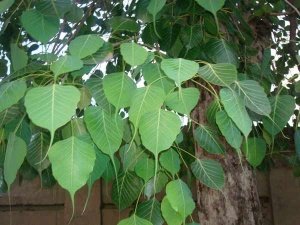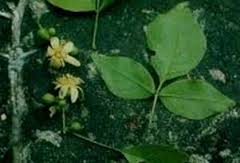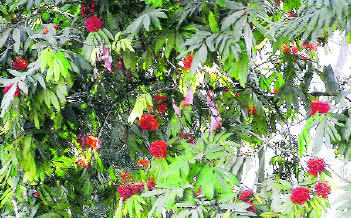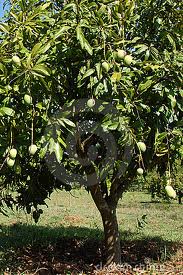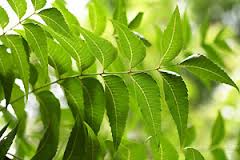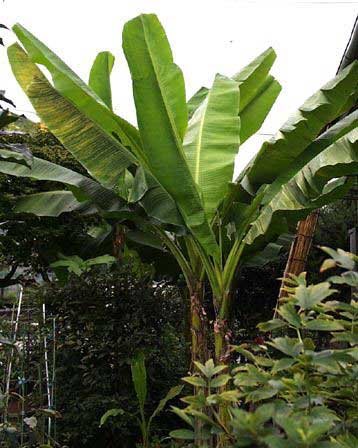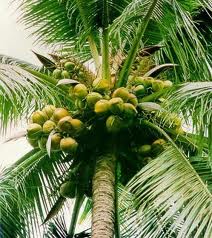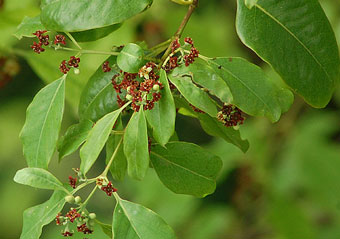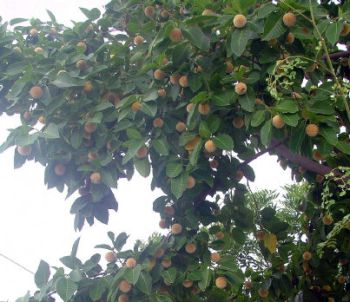Udupi; Dec 05: Indians have been worshipping trees since time immemorial and this is done as a matter of gratitude because we know that life cannot exists without trees. In Indian culture trees are believed to have conscious like humans so they can feel pain as well as happiness like us. So trees and their products are part of our rituals and ceremonies. With passage of time different trees like neem (Azadirachta indica), banyan (Ficus bengalensis), bel (Aegle marmelos) and many more have been added to the religious sanctity. Even various Gods and Goddess have been associated with different trees like bel, rudraksa (seeds of Elaeccarpus) are close to Lord Shiva, peeped to Lord Visnu, mango (Mangifera indica) to Lord Hanuman, Asoka to Kamadeva, etc. Here is a brief introduction to some of the most sacred trees in India
Peepal Tree – The most worshipped tree in India which in Sanskrit is known as “Ashvattha”. Peepal tree is also known as Bodhi tree or tree of enlightenment as it is believed that Buddha attained enlightenment under peepal tree. This is the reason why Peepal tree is sacred to Buddhist. Also the present Kali Yuga began with the death of Lord Krishna that had happened under this tree only. In Hinduism it is believed that roots of Peepal tree are Brahma, the trunk is Vishnu and the leaves are Shiva. A red thread or cloth is tied around Peepal tree for worship so cutting down Peepal tree is considered inauspicious.
Banyan Tree – It is believed that three gods – Lord Vishnu, Lord Shiva and Lord Brahma are symbolized by the Banyan tree. Mostly the childless couple worship banyan tree and it is supposed not to be cut. In most of the Hindu cultures, this tree represents life and fertility.
Bel Tree – Bel is another very auspicious and sacred tree in India that is supposed to be associated with Lord Shiva. To please Lord Shiva, leaves of Bel tree are offered to Him and thus known as bilva. Bel leaves are trifoliate or tripatra and it is believed that it symbolizes three work of Lord – the preservation, creation and destruction as well as three eyes of the Lord. So during the worship of Lord Shiva offering Bel leaves is compulsory.
Ashoka Tree – Ashoka is one of the most sacred and well-known trees of India. In Sanskrit, Ashoka means without grief or the one who gives no grief. As per Hinduism, Kama Deva (Lord of Love) is associated with Ashoka tree. Even Sita Devi was kept by Ravana in Asoka Vatika.
Mango Tree – Mango tree is another very sacred tree in India whose leaves, wood as well as fruits are used in many rituals. To mark any auspicious occasion, string made from mango leaves is hung on the entrance. Mango leaves are kept in the pot with coconut during Kalash Sathapana. Blossoms of Mango tree are offered to Goddess Saraswati on Basant Panchami. Mango tree is also very auspicious for Buddhists as it is believed that Lord Buddha had created a huge mango tree at Shravasti from the seed.
Neem Tree – Many medical benefits are associated with neem tree and because of this it is highly respected in India. It supposed to be an expression of Goddess Durga. In Bengal, the tree is believed to be a place of living of ‘Sitala’ the great Pox-mother who can cause and cure disease. To cure pox, neem leaves are rubbed on the body and by offering a prayer to her. It is also believed that smoke produced by burning neem leaves keep the evil spirits away from you and your home. Mahatma Gandhi was a great believer in neem.
Banana Tree – It is really a very auspicious tree in India. Its every part is used in performing one or the other ritual. Like welcoming gates are made by using trunk, leaves are used to distribute Prasad, fruit is offered to Lord Vishnu and Goddess Lakshmi. Banana tree is also worshipped in Kadali Vrata. Banana tree with flowers and fruits is worshipped for the welfare of the family.
Coconut Tree – Coconut tree, especially in South India is one of the most sacred trees and must for a family to plant it at home. Coconut is used while performing all the Hindu rituals and offered in all kinds of pujas. Even before any puja, sthapana with water filled pot, mango leaves and coconut is done. It actually symbolizes Goddess Lakshmi. It is considered that three black marks on coconut shell are the three eyes of Lord Shiva.
Sandal wood Tree – For worshipping Gods, paste and oil of sandal wood tree are used. Sandal wood imparts fragrance to everything even to the axe that is used to cut this tree. So anything that is just excellent is known as chandana. Holy places are purified with chandan.
Kadamb Tree – It is the tree of Lord Krishna as he used to play his flute under this tree. His childhood activities like jumping in Yamuna, dancing with gopis, climbing on the trees were all done on or around Kadamb tree. So flowers of Kadamb tree are offered at various temples.

